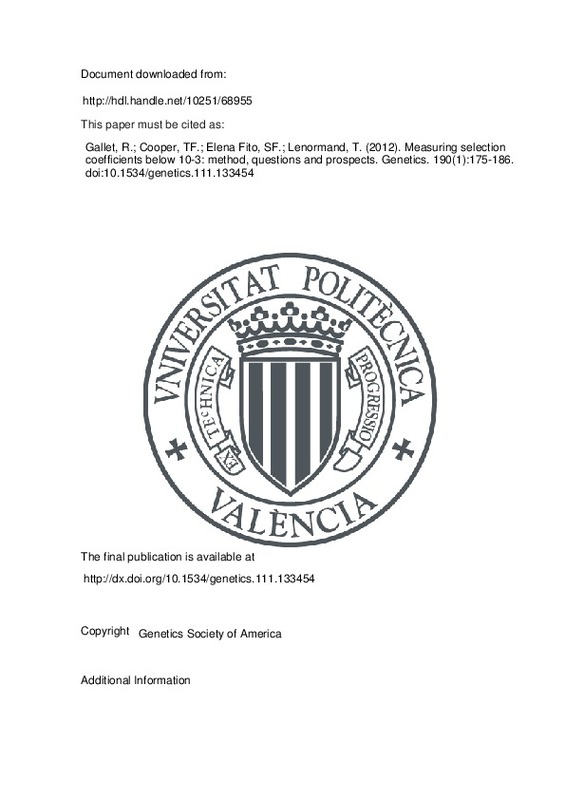JavaScript is disabled for your browser. Some features of this site may not work without it.
Buscar en RiuNet
Listar
Mi cuenta
Estadísticas
Ayuda RiuNet
Admin. UPV
Measuring selection coefficients below 10-3: method, questions and prospects
Mostrar el registro sencillo del ítem
Ficheros en el ítem
| dc.contributor.author | Gallet, Romain
|
es_ES |
| dc.contributor.author | Cooper, Tim F.
|
es_ES |
| dc.contributor.author | Elena Fito, Santiago Fco
|
es_ES |
| dc.contributor.author | Lenormand, Thomas
|
es_ES |
| dc.date.accessioned | 2016-09-07T08:26:52Z | |
| dc.date.available | 2016-09-07T08:26:52Z | |
| dc.date.issued | 2012-01 | |
| dc.identifier.issn | 0016-6731 | |
| dc.identifier.uri | http://hdl.handle.net/10251/68955 | |
| dc.description.abstract | [EN] Measuring fitness with precision is a key issue in evolutionary biology, particularly in studying mutations of small effects. It is usually thought that sampling error and drift prevent precise measurement of very small fitness effects. We circumvented these limits by using a new combined approach to measuring and analyzing fitness. We estimated the mutational fitness effect (MFE) of three independent mini-Tn10 transposon insertion mutations by conducting competition experiments in large populations of Escherichia coli under controlled laboratory conditions. Using flow cytometry to assess genotype frequencies from very large samples alleviated the problem of sampling error, while the effect of drift was controlled by using large populations and massive replication of fitness measures. Furthermore, with a set of four competition experiments between ancestral and mutant genotypes, we were able to decompose fitness measures into four estimated parameters that account for fitness effects of our fluorescent marker (alpha), the mutation (beta), epistasis between the mutation and the marker (gamma), and departure from transitivity (tau). Our method allowed us to estimate mean selection coefficients to a precision of 2 x 10(-4). We also found small, but significant, epistatic interactions between the allelic effects of mutations and markers and confirmed that fitness effects were transitive in most cases. Unexpectedly, we also detected variation in measures of s that were significantly bigger than expected due to drift alone, indicating the existence of cryptic variation, even in fully controlled experiments. Overall our results indicate that selection coefficients are best understood as being distributed, representing a limit on the precision with which selection can be measured, even under controlled laboratory conditions. | es_ES |
| dc.description.sponsorship | We thank E. Flaven, M.-P. Dubois for lab management, C. Duperray (IRB - Montpellier), C. Mongellaz (IGM, Montpellier), and the Montpellier RIO Imaging platform for training R.G. to flow cytometry and their help in designing the cytometer protocols, N. Le Meur for her help with the flowCore R package, and L. M. Chevin, P. A. Gros, G. Martin, and F. Rousset for fruitful discussions and insightful comments. We also thank two anonymous reviewers for useful comments. This work was supported by the European Research Council Starting Grant 'Quantevol' to T.L. and a National Science Foundation grant (IOS-1022373) to T.F.C. | |
| dc.language | Inglés | es_ES |
| dc.publisher | Genetics Society of America | es_ES |
| dc.relation.ispartof | Genetics | es_ES |
| dc.rights | Reserva de todos los derechos | es_ES |
| dc.title | Measuring selection coefficients below 10-3: method, questions and prospects | es_ES |
| dc.type | Artículo | es_ES |
| dc.identifier.doi | 10.1534/genetics.111.133454 | |
| dc.relation.projectID | info:eu-repo/grantAgreement/NSF/Directorate for Biological Sciences/1022373/US/ | |
| dc.rights.accessRights | Abierto | es_ES |
| dc.contributor.affiliation | Universitat Politècnica de València. Instituto Universitario Mixto de Biología Molecular y Celular de Plantas - Institut Universitari Mixt de Biologia Molecular i Cel·lular de Plantes | es_ES |
| dc.description.bibliographicCitation | Gallet, R.; Cooper, TF.; Elena Fito, SF.; Lenormand, T. (2012). Measuring selection coefficients below 10-3: method, questions and prospects. Genetics. 190(1):175-186. https://doi.org/10.1534/genetics.111.133454 | es_ES |
| dc.description.accrualMethod | S | es_ES |
| dc.relation.publisherversion | https://doi.org/10.1534/genetics.111.133454 | es_ES |
| dc.description.upvformatpinicio | 175 | es_ES |
| dc.description.upvformatpfin | 186 | es_ES |
| dc.type.version | info:eu-repo/semantics/publishedVersion | es_ES |
| dc.description.volume | 190 | es_ES |
| dc.description.issue | 1 | es_ES |
| dc.relation.senia | 232191 | es_ES |
| dc.identifier.pmid | 22042578 | |
| dc.identifier.pmcid | PMC3249376 | |
| dc.contributor.funder | National Science Foundation, EEUU |







![[Cerrado]](/themes/UPV/images/candado.png)

